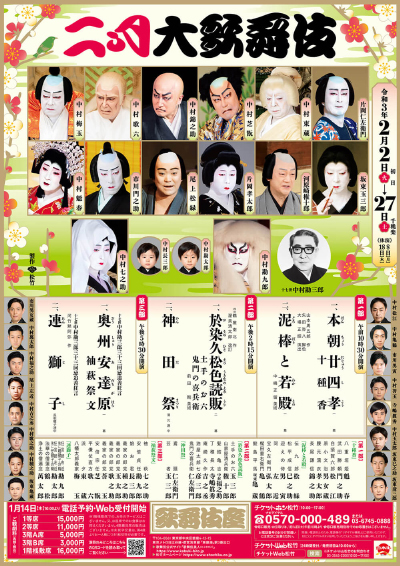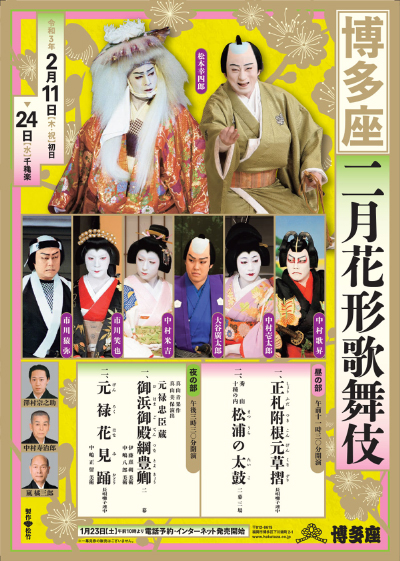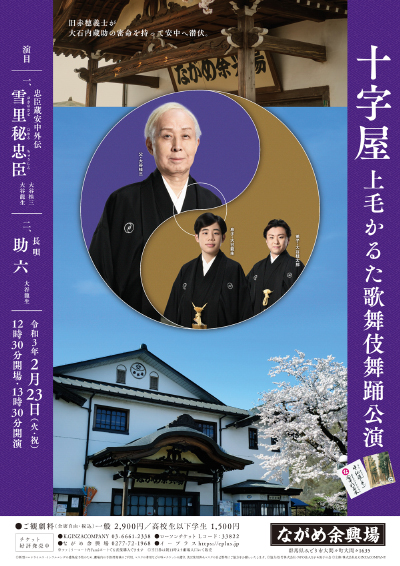| Casting |
Living National Treasure Kataoka Nizaemon, Living National Treasure Band˘ Tamasabur˘, Living National Treasure Nakamura T˘z˘, Nakamura Shikan, Nakamura Baigyoku, Nakamura Kaishun, Nakamura Kinnosuke, Nakamura Shichinosuke, Kataoka Takatar˘, Nakamura Kankur˘, Onoe Sh˘roku, Band˘ Minosuke, Nakamura Karoku, Band˘ Hikosabur˘,
Band˘ Kamez˘, Ichikawa Monnosuke, Nakamura Kikaku, Kawarasaki Gonjűr˘, Ichikawa Omez˘, Nakamura Matsue, Nakamura Kangyoku, Nakamura Fukunosuke, Nakamura Mantar˘, Nakamura Tanenosuke, Nakamura Tsurumatsu, Nakamura Tamatar˘, Nakamura Utanosuke, Ichikawa Otora, Onoe Sakon, Nakamura Kichinoj˘, Nakamura Kantar˘, Nakamura Ch˘zabur˘, Terajima Maholo
|
| Comments |
The February Grand Kabuki at the Kabukiza. The third program commemorates the 32nd anniversary (33rd memorial services) of the passing away of Nakamura Kanzabur˘ XVII.
Jusshuk˘: Princess Yaegaki is mourning the death of his fiance Katsuyori,
but as she burns incense in his memory, she notices the resemblance between the new gardener and her fiance's portrait.
The gardener is in fact Katsuyori, who has entered the household of Yaegaki's father to regain the
possession of a stolen family treasure, a famous helmet, with the help of Nureginu, a woman who also mourns for the man that died
in the place of the real Katsuyori. Unfortunately, Yaegaki's father has also seen through the disguise and plans to kill Katsuyori.
The role of Princess Yaegaki, one of the most important onnagata roles,
is played by Nakamura Kaishun, supported by Ichikawa Monnosuke, Kataoka Takatar˘ and Nakamura Kinnosuke in the roles of Katsuyori, Nureginu and Nagao Kenshin.
Dorob˘ to Wakatono:
(The Thief and the Samurai Lord)
This is a new play that is a dramatization of a story by popular historical novelist
Yamamoto Shűgor˘ which depicts the heartwarming bond between an ill-fated young lord and a good-natured thief. Matsudaira Narinobu (Band˘ Minosuke), the second son of lord Matsudaira ďinokami, is confined in a dilapidated house due to a conspiracy hatched by the evil chief retainer.
The thief Denkur˘ (Onoe Sh˘roku) breaks into the house but finds nothing to steal. Feeling pity for Narinobu who has not enough to eat, he takes care of him. After that, the extraordinary coexistence of Denkur˘ and Narinobu begins...
This is a heart-warming piece depicting the bond between the charming and sympathetic thief, and the pessimistic and ill-fated young lord.
Dote no Oroku/Kimon no Kihŕ: this is a play written by Tsuruya Nanboku IV,
and these scenes in particular reflect the decadence and corruption found in the underbelly of ordinary society
at that time. The scenes portray two outwardly charming characters who are filled with wickedness.
There are several typical role types that appear in Kabuki, and akuba (wicked lady)
is one of them. Oroku is an akuba and although beautiful,
she is truly wicked. Trying to extort 100 gold coins, Oroku and her husband Kimon no Kihŕ visit a pawnshop carrying the
dead body of Oroku's brother. The two insist that her brother died from an injury he incurred in a
quarrel with its apprentice. However, the dead body suddenly becomes conscious and the extortion ends in failure.
Although disappointed, the two leave the pawnshop without flinching in the slightest.
Starring Living National Treasures Band˘ Tamasabur˘ and Kataoka Nizaemon in the roles of Oroku and Kihŕ.
Featuring also Band˘ Hikosabur˘ and Kawarasaki Gonjűr˘.
Kanda Matsuri:
(The Kanda Festival)
The gallant commoners of Edo's neighborhoods loved nothing better than a festival, and this performance is a dance based on one of the biggest festivals in Edo (Kanda Matsuri).
In this dance, a gallant fireman (Living National Treasure Kataoka Nizaemon) and a geisha (Living National Treasure Band˘ Tamasabur˘) appear on stage and display their 'Edo-style' spirit. In the end, a young man comes out and a beautiful fighting scene unfolds on stage.
Sodehagi Saimon: a larger-than-life history play originally
written for the puppet theater, this is an epic of the intrigues in the
T˘hoku region of Japan. It shows the larger political movements of the
region as the individual tragedies of various people that are caught in
this turmoil. In the most famous section, this play tells the tragic
story of Sodehagi (Nakamura Shichinosuke), a woman disowned by her family after falling in
love with a man that they did not accept. Now she is alone and blind
from weeping. She wanders with her child, supporting them as a
musician and comes to her family's house. They do not let her in and
sitting outside in the snow, she sings her tragic tale.
Meanwhile, her husband Abe no Sadat˘ (Nakamura Kankur˘) is inside the house, in a story of
political intrigue. Featuring also Nakamura Baigyoku, Nakamura Shikan, Nakamura Karoku and Living National Treasure Nakamura T˘z˘ in the roles of Hachiman Tar˘, Abe no Munet˘, Taira no Kenj˘ Naokata and Kenj˘'s wife Hamayű.
Renjishi: 2 entertainers dance a tale of the legendary shishi or lion-like spirits that live at the foot of a
holy Buddhist mountain. There is a comic interlude with 2 Buddhist pilgrims. Then, the shishi themselves appear and perform their dance with wild shaking of their long manes.
The dance shows a parent shishi forcing his cub to undergo harsh training in order to grow up strong.
This theme is often associated with the training a parent actor gives his son.
This performance features Nakamura Kankur˘ in the role of the parent shishi and
his son Nakamura Kantar˘ in the role of the cub.
Sources: Earphone Guide Website or Sh˘chiku Kabuki Official Website
|




